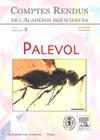阿根廷下泥盆纪dalmanitid三叶虫新分类群:南方高古纬度特有分类群的刺性
IF 1.3
4区 地球科学
Q3 PALEONTOLOGY
引用次数: 1
摘要
在阿根廷Precordillera盆地Talacasto组发现了3个新的下泥盆统dalmanitid三叶虫分类群,包括2个单属(Ivanites leonorae n. gen., n. sp.和Aguaditaspis mediaspina n. gen., n. sp.)和1个开放命名的新属和新种。这些分类群结合了Dalmanitinae Vogdes(1890)和Synphoriinae Delo(1935)亚科的特征,挑战了它们的分类区别。冈瓦纳西南部高古纬度盆地中,40%的dalmanitid表现出非同源背棘。Aguaditaspis mediaspina n. gen., n. sp.与锥虫(Trypaulites calypso)有相似的刺(Hall, 1861)。这个未命名的新属类似于Malvinokaffric dalmaniids特有的刺,如Dalmanitoides Delo(1935)和Fenestraspis Braniša & van本文章由计算机程序翻译,如有差异,请以英文原文为准。
New dalmanitid trilobite taxa from the Lower Devonian of Argentina: comments on spinosity in endemic taxa from southern high paleolatitudes
Three new Lower Devonian dalmanitid trilobite taxa are recognized from the Talacasto Formation in the Precordillera Basin, Argentina, which includes two monospecific genera (Ivanites leonorae n. gen., n. sp. and Aguaditaspis mediaspina n. gen., n. sp.), and one additional new genus and species left in open nomenclature. These taxa combine characters of the subfamilies Dalmanitinae Vogdes, 1890 and Synphoriinae Delo, 1935, challenging their taxonomic distinction. Forty percent of the dalmanitids from high paleolatitudinal basins from southwestern Gondwana (Malvinokaffric) exhibit non-homologous dorsal spinosity. Aguaditaspis mediaspina n. gen., n. sp. shares similar spines with Trypaulites calypso (Hall, 1861). The unnamed new genus resembles the spinosity of endemic Malvinokaffric dalmanitids, like Dalmanitoides Delo, 1935 and Fenestraspis Braniša & Vaněk, 1973. Considered defensive, the recorded spinosity along with putative sublethal-attack marks, suggest higher predation pressure than previously thought at high paleolatitudes. This evidence is in accordance with some hypothesis on rising predation pressure in the mid-Paleozoic marine ecosystems.
求助全文
通过发布文献求助,成功后即可免费获取论文全文。
去求助
来源期刊

Comptes Rendus Palevol
地学-古生物学
CiteScore
2.10
自引率
0.00%
发文量
39
审稿时长
17.6 weeks
期刊介绍:
Comptes Rendus Palevol is a fully electronic and peer-reviewed journal, with a continuous publication stream, devoted to palaeontology, prehistory and evolutionary sciences. It publishes original research results, in French or English, in the following domains: systematic and human palaeontology, prehistory, evolutionary biology and macroevolution, and history of sciences. Thematic issues may also be published under the responsibility of a guest editor. All articles published in Comptes Rendus Palevol are compliant with the different nomenclatural codes. A copyright assignment will be signed by the authors before publication.
 求助内容:
求助内容: 应助结果提醒方式:
应助结果提醒方式:


